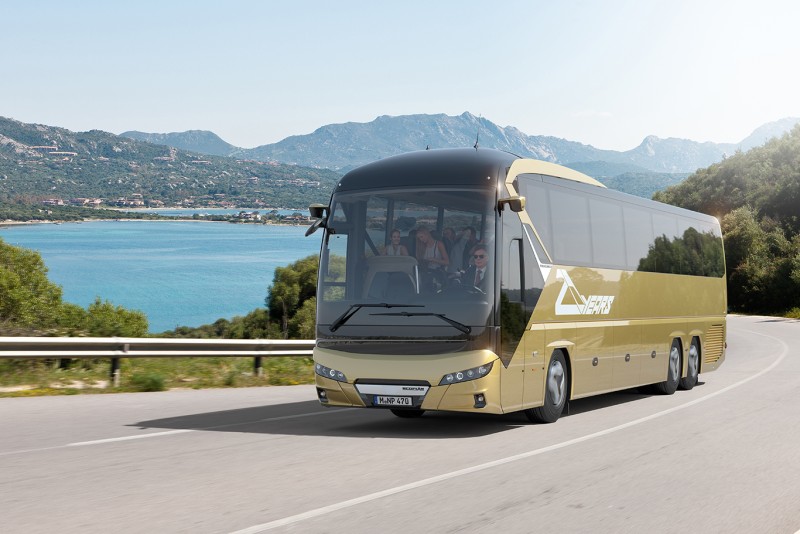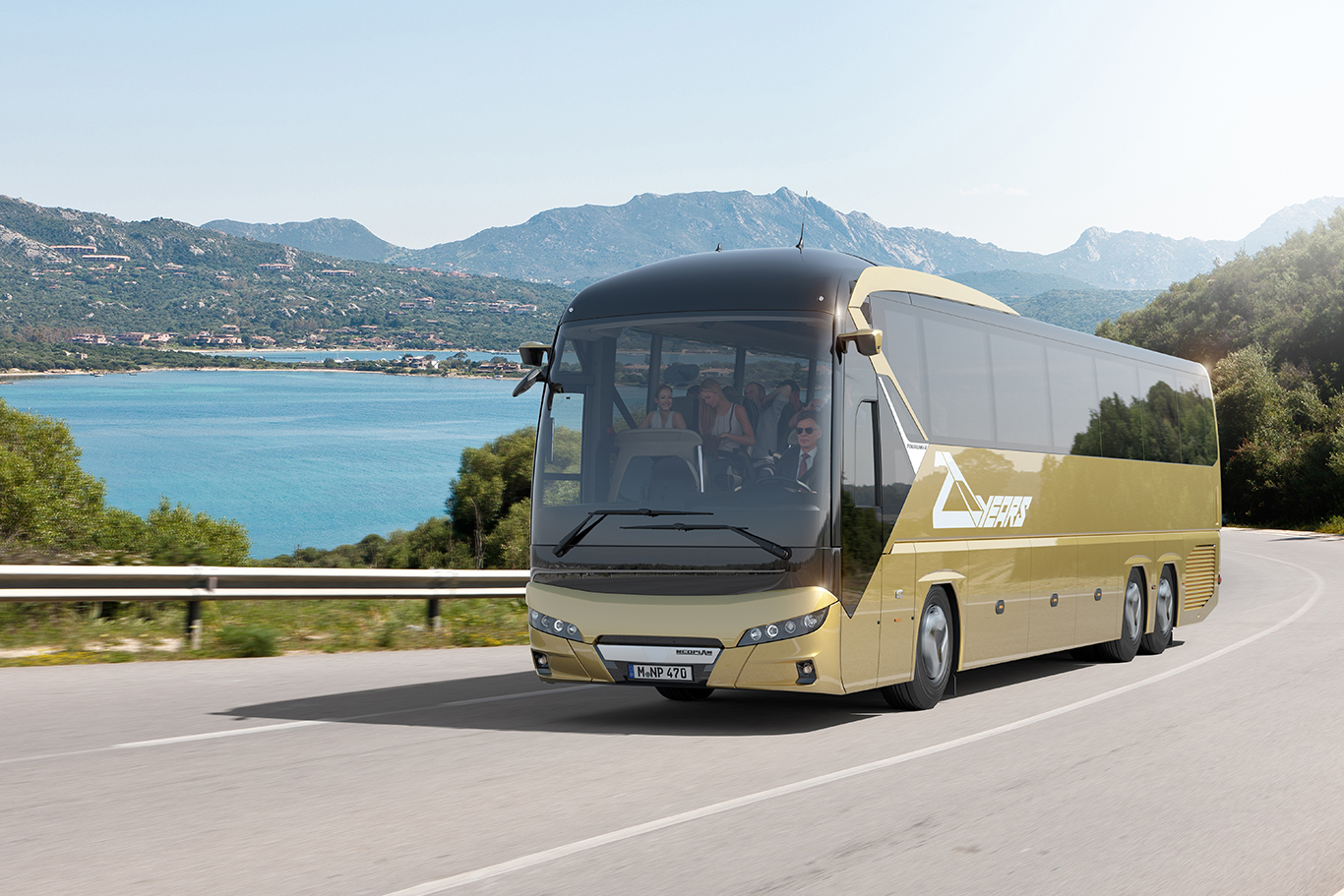
The Tourliner coach was launched as a new entry-level class for the NEOPLAN premium brand 20 years ago. Following shortly after MAN's takeover of Gottlob Auwärter GmbH & Co KG in Stuttgart-Möhringen, this was one of the first coaches to be built on the common MAN technology platform. Today, the Tourliner has matured significantly in its second generation and has now firmly established itself on Europe’s roads. For the new model year, which MAN Truck & Bus will be presenting for the first time at Busworld 2023 in Brussels it will receive another major technical upgrade.
- Attractive entry-level model into the NEOPLAN world
- Award-winning Sharp Cut design with OptiView system
- Four lengths and a flat floor ensure maximum flexibility for customers
- Efficient MAN engines and outstanding safety make the Tourliner a popular all-rounder
- More than 3,850 vehicles have been sold since it was launched in 2003 – two thirds of them in the popular 12-metre two-axle version
Now spanning two decades, the history of the Tourliner is closely linked to that of the Stuttgart-based tradition-rich NEOPLAN brand, which will celebrate its 90th anniversary in 2025. For decades now, the brand has stood for high-quality, innovative coaches that use highly reliable technology. One of the most important dates in the NEOPLAN company history in the new millennium is without doubt 20 June 2001: this was the day on which Gottlob Auwärter GmbH & Co. KG was acquired by MAN Nutzfahrzeuge AG in Munich – thus establishing an important milestone for the future development of the company.
NEOPLAN and the bus division of MAN were initially managed under the umbrella of NEOMAN GmbH in Salzgitter. On 1 February 2008, the bus division was then integrated into the MAN Nutzfahrzeuge Group in order to benefit from the synergies within the internationally active Group. Today, all NEOPLAN models are built in the modern MAN bus plant in Ankara – a tradition that was successfully started with the new Tourliner in 2003. The vehicle was still presented in the former parent factory in Möhringen under the motto “Tourliner Summertime” in July 2003. An initial design concept had previously been presented at the IAA 2002 under the name “X-liner” – the vehicle created a stir not least due to its fluorescent green paintwork. For the start of sales of the two models as a two-axle vehicle (Tourliner SHD) and long three-axle vehicle (Tourliner SHD L), many changes were therefore incorporated based on customer feedback.
Development of the first generation
The idea at the time was both simple and made industrial sense. MAN’s standard Lion’s Coach – developed under the aegis of former technology director Ernö Bartha – had recently been revamped in 2002 and was to serve as the technical basis for the first NEOPLAN coach. The goal was to supplement the tradition-rich model range of Starliner, Cityliner, Skyliner and Euroliner and to extend it into the standard coach segment. The Tourliner was also one of the first models from the drawing board of the newly set up NEOPLAN design department headed by Michael Streicher (Exterior) and Andrea Lipp (Interior). Michael Streicher quickly became known as the creator of the NEOPLAN-specific and brand-defining Sharp Cut design for the Starliner and Cityliner. The styling can also be found in the essence of the second generation of the vehicle with its clearly defined "Angel Eyes”.
The first-generation Tourliner was a typical “child of its time”. Since it shared the skeleton – an important basic component of every bus – with its MAN counterpart, the traditionally forward-angled window pillars and split windscreen were omitted here for the first time, as on the economical Euroliner intercity/touring coach, thus permitting clear differentiation from the Starliner and Cityliner premium products. In spite of this, the design team still succeeded in providing the coach with an extremely dynamic appearance through the significantly forward sloping B-pillar as a characteristic design element – and this is how it has remained up to the present day. Instead of the free-form headlights of the MAN Lion coach, the Tourliner shone with the typical NEOPLAN single-spotlight headlights, while round LED lights were used at the rear – well before they were introduced on other buses. Overall, the design very cleverly shows the transition in the NEOPLAN design language from the previous century to the new one, without stealing the thunder for the two new Starliner and Cityliner models, which were launched shortly afterwards. The interior of the first Tourliner still featured many rounded elements and the light-blue interior (Beach Blue) that had been popular over many years. In contrast to the MAN brother, the first generation also had the platforms typical for NEOPLAN.
With these high-quality characteristics, it did not take long for the NEOPLAN Tourliner to excite a wide range of customers. A total of around 2,500 vehicles from the first generation were registered, including right-hand-drive models that were marketed above all in the United Kingdom. Of these around 70 per cent were the 12-metre two-axle version. One coach even found its way to the 2010 Football World Cup in South Africa, while other models were fitted out as exclusive team buses, above all for professional cycling. Thanks to its attractive price-performance ratio, the Tourliner has always also been a popular choice for long-distance scheduled service operation – not least due to the now continuous flat floor and the optional wheelchair lift above the front or rear axle.
Second generation sets standards
Just like back then, NEOPLAN continues to set benchmarks with its vehicles to this very day. The current product range impresses with exclusive vehicles that always attract enthusiastic looks thanks to their individual design. This is particularly true for the second generation of the Tourliner presented in 2016. Here, the optimised Sharp Cut design with clear, precise contours sets new visual standards. Its aerodynamic design was revamped to achieve improvements of around 20 per cent, resulting in extremely low drag and benchmark values in the wind tunnel. This was made possible by numerous details such as the smooth transition between the windscreen and roof dome, the aerodynamically optimised A-pillar and the smooth-surface side wall. The new Tourliner thus combines dynamic and aesthetic elements in a unique way. A key element of the design that has set the model apart for several years is created by visually breaking up the wide forward-oriented B-pillar so that passengers in the first seat row can still easily see outside – and the exterior appearance is given a special look at the same time. Taking a closer look, you can recognise the dynamic of the forebody in the “transparent wings” of the 20-year campaign logo.
Speaking of aerodynamics, the OptiView digital mirror-replacement system makes it possible to significantly reduce drag. This technology also offers advantages in terms of safety and cost-effectiveness. The world’s first mirror replacement system for coaches was a genuine unique selling point on the market when introduced in 2018 and has since firmly established itself.
It only takes one look to see that the second-generation Tourliner is part of the NEOPLAN family. The front dome that extends stylishly into the roof, the dynamic comet’s tail of the trim in front of the roof air conditioning system, the distinctive and well-defined headlights (“Angel Eyes”) and the Sharp Cut design that has already received multiple accolades all make it clear that this is a true NEOPLAN. The Tourliner – which received the iF Design Award shortly after its launch – also impresses with an extremely welcoming atmosphere and maximum travel comfort. High-quality materials, the modern lighting concept of the new generation and the comprehensive infotainment equipment leave nothing to be desired. Passengers enjoy an abundance of light and a feeling of spaciousness. The floating design of the luggage racks, LED lighting and new service sets also contribute to this. The Tourliner received further interior enhancements over the course of the following years. The most important new features that contribute to the premium presence of the Tourliner are the floor in boat deck look, the chrome handrails, and the backlit elements on the luggage racks that also discreetly highlight the product name in the interior through LED lighting. The Tourliner can naturally also be upgraded with further modules from the NEOPLAN Individual range.
The second generation of the Tourliner model line is available in four variants and therefore offers every customer the best possible solution for their individual needs – flexibility has always been a key focus at NEOPLAN. The smallest variant with a length of 12.1 metres offers premium comfort for a maximum of 53 passengers. The three-axle medium-sized variant – the Tourliner C with a length of 13.4 metres – can accommodate up to 57 passengers. The extra-long two-axle vehicle followed as the latest addition to the family at the Busworld 2017. The two-axle version of the Tourliner C with a length of 13.1 metres is optimised, in particular, for maximum seating, offering up to 59 seats – ideal for long-distance scheduled service. As the largest variant with a length of 13.9 metres, up to 63 passengers enjoy the exclusive comfort of the three-axle Tourliner L.
Since its launch in 2003, a total of around 3,850 NEOPLAN Tourliner vehicles from both generations have left the assembly line – of these, more than 2,500 in the popular 12-meter two-axle version. To coincide with the 20-year anniversary of the NEOPLAN Tourliner, the model will also be launched as a particularly high quality Diamond Edition. This will cover the whole model range and emphasises the special family feeling of the premium brand.




Kein Kommentar / There is no comment / 댓글은 힘이 됩니다.